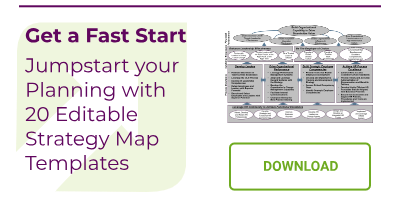It's hard to believe that so many organizations still rely on spreadsheets as their primary tool for tracking their strategy. On the surface, it makes sense. Spreadsheets are familiar, accessible, and dangerously flexible. They appear to be the ideal default tool for tracking goals and measuring progress. A Swiss army knife for countless business use cases.
But this familiarity masks significant limitations that ultimately hinder your strategic execution. It's time to address the elephant in the room: using spreadsheets to manage your strategy is actually a bad strategy.
Consider this scenario: Your leadership team spent months developing a comprehensive strategic plan. Everyone is excited and committed. Countless hours have been invested. Then reality hits. Each department creates their own spreadsheets. Versions multiply. Data becomes inconsistent. Or worse yet, there is one shared spreadsheet that is continuously overwritten with data and riddled with errors. Soon, people become fatigued with the entire process. And suddenly, no one knows which numbers to trust anymore. The entire strategy project is now in jeopardy.
Sound familiar? Let's explore why spreadsheets fall short in strategy management and then explore a solution to address this challenge.
Why Spreadsheets Fail Your Strategy
1. The Collaboration ConundrumStrategy execution requires seamless collaboration across departments and teams. Spreadsheets were never designed for multiple users updating information simultaneously. The result?
- Version control nightmares ("Is this the latest update?")
- Data silos that prevent cross-functional alignment
- Bottlenecks as teams wait for updates from the "spreadsheet keeper"
- Time wasted consolidating inputs from various stakeholders
Effective strategy execution demands real-time collaboration that spreadsheets simply cannot provide.
2. Missing the Forest for the TreesSpreadsheets excel at storing data points but fall short at visualizing relationships between strategic elements. They’re not effective at showing:
- How initiatives connect to strategic objectives
- The cause-and-effect relationships between different metrics
- Alignment of strategic elements between multiple departments
- The big picture view needed for strategic decision-making
- Visual process flow charts and illustrations of the strategy
Without interactive strategy maps, alignment reports and visual dashboards, leaders struggle to see how different parts of the strategy interconnect—making it challenging to both tell the story of the strategy and to course correct when needed.
3. Manual Data Collection = Endless HeadachesThe true cost of spreadsheet-based strategy tracking becomes apparent when considering the time spent on manual data collection:
- Hours spent emailing stakeholders for updates and chasing those who are non-compliant
- Tedious copy-pasting between documents
- Manual formula checking and maintenance
- Time wasted formatting reports for executive presentations with changes to metrics and analysis flowing in hours before the big meeting
This administrative burden diverts attention from what truly matters: analysis, insight, and action.
4. Lack of Standardization Leads to Inconsistent ResultsWithout standardized data collection methods, each team develops their own collection processes, their own calculations, assumptions, and way of interpreting their metrics:
- Inconsistent calculation methodologies
- Varying reporting timeframes
- Different formatting and presentation standards
- No clear audit trail for changes
The result? Leaders making critical decisions based on inconsistent and potentially misleading information. And a lot of time wasted on low value activities.
5. Strategy Requires a Process that Excel Doesn't Support
Effective strategy execution isn't just about data—it's about process. Spreadsheets were never designed to support the cyclical, collaborative process that strategy management demands:
- No built-in ownership and accountability tracking for goals, metrics and initiatives
- Lack of structured performance analysis workflows
- No mechanism for documenting recommendations based on performance data
- No calendar-driven review and update cycles
- No real-time performance alerts, notifications, or reminders to engage participants
- No way to link analyses to executive decision-making processes
Strategy management requires a rhythm—regular reviews, structured analyses, and disciplined follow-up. Excel simply wasn't built to orchestrate this crucial process.
A Better Approach: Purpose-Built Strategy Management
Forward-thinking organizations are abandoning spreadsheets in favor of dedicated strategy management platforms designed specifically for strategy execution.
The right strategy management solution offers:
- Collaborative Environment: Multiple stakeholders updating information simultaneously without version control issues
- Interactive Strategy Maps: Visual representations showing how various elements of your strategy connect, allowing everyone to understand how they contribute and fit in
- Standardized Data Collection: Consistent methodologies and formats across the organization
- Automated Reporting: No more manual PowerPoint creation for strategy review meetings
- Real-Time Dashboards: Up-to-the-minute visibility into performance against goals
- Best Practice Frameworks: Built-in methodologies like Balanced Scorecard or OKRs
- Integrated Initiative Management: Connect strategic objectives directly to the work that drives results
The Real Cost of Sticking with Spreadsheets
The true cost of spreadsheet-based strategy management isn't just inefficiency—it's missed opportunities and failed execution.
When you can't quickly identify underperforming areas, when you waste time hunting down data instead of acting on insights, when your teams aren't aligned around common goals—that's when strategies fail to deliver results.
In contrast, organizations using dedicated strategy management platforms report:
- More effective strategy execution
- Better alignment across departments
- Faster identification and resolution of performance issues
- More productive strategy review meetings
- Higher employee engagement with strategic initiatives
- Greater confidence in decision-making
- Higher ROI on the investment of time and consultants to create and implement the strategy
Take the First Step Toward Better Strategy Execution
If you're still tracking your strategy in spreadsheets, it's time to ask yourself: Can we afford to continue managing our most important priorities with tools that weren't designed for the job?
The future belongs to organizations that can execute strategy with agility, alignment, and accountability. Isn't it time your tools matched the importance of your strategy?
Ready to leave spreadsheets behind? Schedule a free demo today to see how a purpose-built strategy management platform can transform your ability to execute with confidence.
Or start your free trial and experience the difference firsthand. Your strategy deserves better than spreadsheets—and so does your team.







